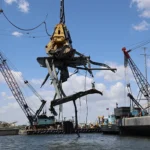The investigation into a bullet train crash in China last summer that killed 40 people has come and gone with no public report on what led to the disaster.
The secrecy surrounding the probe, which ended in September, is typical of the sensitivities shown toward wider troubles plaguing the showcase high-speed rail program.
The accident inflamed criticism that the powerful Railway Ministry may be sacrificing safety in its costly quest to quickly roll out the bullet train network. Shortly after the July 23 crash, Premier Wen Jiabao called for a sweeping and transparent investigation.
Based on regulations on major transport accidents, a report on the accident was due by Nov. 20. Railway Ministry officials refused comment Tuesday.
The few slivers of information about the probe have been quickly recanted.
A railway expert and deputy director of the investigation team, Wang Mengshu, backtracked from comments in the state-run Beijing Times newspaper quoting him as saying the crash near the eastern city of Wenzhou largely resulted from mismanagement.
State media on Tuesday carried reports of Wang claiming he was misquoted, that his comments were only his personal opinion, and that he was not authorized to speak to the media.
“I was not involved in the whole investigation. I did not have a general idea of the whole thing, and I did not know whether the conclusion had been submitted,” Wang told state-run CCTV.
Wang did not respond to calls and e-mailed requests for comment.
In comments on the work safety administration’s website, Wang promised full and accurate disclosure of the probe’s findings.
The lack of transparency has left some in China skeptical that problems with the high speed rail network are being resolved, said Li Hongchang, an economics professor at Beijing Jiaotong University.
“People want not just the report but to understand how it was compiled. Openness and credibility are actually more important than the report itself,” Li said.
Shortly after the accident, authorities blamed problems with the high-tech signaling systems used to run and route the trains for the crash. The collision occurred after railway staff failed to notice anything amiss when a lightening strike stalled a train and the signaling system failed to turn red.
But they have since backed away from that analysis. The Beijing Times report quoted Wang as saying the lack of problems with the same signaling systems on other lines suggests human error was to blame.
Similarly, Shanghai authorities initially blamed a Sept. 27 subway crash that injured nearly 300 on malfunctioning signaling systems. Later they said it resulted from mismanagement and inadequate training. A dozen subway workers were punished.
The Wenzhou crash prompted inspections of dozens of projects and 3,700 miles (6,000 kilometers) of bullet train line – but few public disclosures of the results of those checks.
Those working in the industry report widespread problems with skimping on construction materials and other safety compromises as the already heavily indebted Ministry of Railways struggles to pay suppliers and workers.
Reports of uncertified contractors and illegal subcontracting, substitution of substandard cement and steel reinforcing bars and other shortcuts – problems epidemic in China’s construction sector -are raising questions over just how sound all that fancy modern infrastructure will be in years to come.
In one recent case involving construction of a railway line in northeastern China, the ministry ordered almost the entire $360 million project redone after finding that contractors had farmed the work out to unqualified construction companies.
Instead of concrete, the builders filled the railway bridge’s foundations with rocks and sand.
The problems are not limited to construction. After the Wenzhou crash, dozens of CRH 380BL trains used on the recently opened Beijing-to-Shanghai line were recalled. The manufacturer, state-owned CNR Corp., blamed quality defects in outsourced parts for the trains’ braking systems.
The trains were repaired, tested and brought back into service last week.
Li, of Beijing Jiaotong University, says the problems reflect a lack of accountability, and an obsession with growth at any cost.
“There are management problems behind every accident,” Li said. “The railways issues are more fundamental; not just an excessive concentration of power in the Railway Ministry, but also its lack of market-oriented decision making.”
China has 13 high-speed railways in operation, with 26 under construction and 23 more planned, although approvals of new projects were frozen following the Wenzhou crash.
Earlier plans called for expanding the network to 10,000 miles (16,000 kilometers) of track by 2020.
The industry’s troubles became apparent in February, when longtime Railways Minister Liu Zhijun was dismissed for unspecified “severe violations of discipline.”
China originally planned some 700 billion yuan for railway construction this year, but in January-October it spent only 367 billion yuan, down 28 percent from a year earlier.
(Associated Press researcher Fu Ting contributed.)
Was this article valuable?
Here are more articles you may enjoy.

 How the Key Bridge Collapse Continues Reshaping Infrastructure Insurance
How the Key Bridge Collapse Continues Reshaping Infrastructure Insurance  Forecast Calls for Wildfires to Burn More Land Across U.S. This Year
Forecast Calls for Wildfires to Burn More Land Across U.S. This Year  Auto Lobbying Groups Unite to Pressure Trump for Tariff Relief
Auto Lobbying Groups Unite to Pressure Trump for Tariff Relief  La Niña’s End Threatens to Unleash an Active Atlantic Hurricane Season
La Niña’s End Threatens to Unleash an Active Atlantic Hurricane Season 